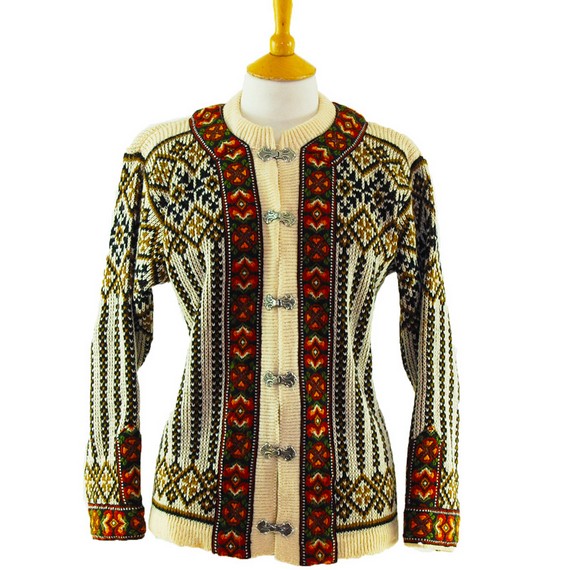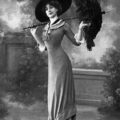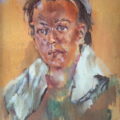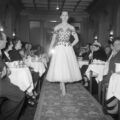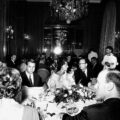Vintage Knitwear – A quick history
August 7, 2017How vintage knitwear developed from the 1900s up to the swinging sixties. From make do and mend, through sweater girls to skinny rib sweaters!
Knitwear History
The history of knitwear goes right back as far as ancient techniques for knotting fishing nets. Finely knitted red socks dating from about the year 250-420 have been discovered in Egypt, and heavy, warm, waterproof jumpers for fishermen have had a practical use going back a long time.
The invention of the stocking knitting frame in 1589 was the beginning of mechanical knitting, which made things a lot faster than hand knitting. The stocking knitting frame was used not just for stockings but also underwear in general alongside hand knitting which of course never died out – knitted vests, knickers and petticoats were worn next to the skin for warmth.
John Smedley
The British knitwear company John Smedley was founded in 1784 and manufactured “Combinations” – a combination of knickers or underpants and a vest. They turned out warm without the gap in the middle – a bit like today’s onesie.
The original John Smedley’s son, also called John Smedly, invented a process to stop the knitwear from shrinking, and also invented long johns, to keep the legs warm under trousers.
Gustave Jaeger
German clothing reformer Gustave Jaeger expounded on the health benefits of wool underclothes in the 19th century and founded a company which is still running.
Vintage knitwear from 1900-1910
Robert Pringle
Another name that’s still recognisable – Robert Pringle. He added knitted lace to the edge of ladies vests, combinations and spencers, (bodices) in 1901. The spencers became fashionable as outwear – almost a century before Madonna started wearing her bras on the outside!
It was fashionable for Edwardian ladies to wear suits of a skirt, blouse and jacket. Occasionally, the jacket, usually made of woven cloth, was replaced by a knitted version.
Swimsuits
Knitted swimsuits began to be worn by men and women. They were form fitting, but not when they were wet! Women also wore knitted stockings in the sea along with little canvas shoes. However, not many women could actually swim, and swimwear was mainly for paddling and playing in the sea. In the photo, although this is a studio shot, you can see the rope that was strung across the sea to hold on to.
1910s vintage knitwear
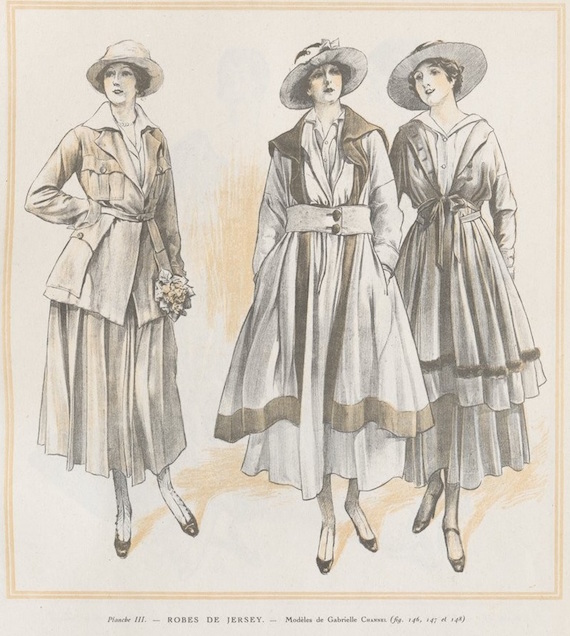
Chanel jersey outfits.
Victorian and Edwardian ladies were tightly corseted as a rule, but suddenly there came a fashion for Orientalism in the shape of flowing, uncorseted tunics, harem pants and turbans, all in bright colours and with extravagant embroideries. Paul Poiret was the main designer behind this, inspired by the Ballet Russe. Knitwear in silky threads lent itself well to this flowing aesthetic as it was heavy and drapy.
First World War
When the war broke out in 1914, many women worked outside the home for the first time. They found feminine knitted Womens vintage jumpers useful and practical as they were easy to launder, easy to move in, and kept the person warm. Soft knitted hats were slowly replacing the elaborate confections that had been worn up to now.
Coco Chanel
Coco Chanel was only one of the designers producing long skirts and nautical looking jackets in jersey for more relaxed seaside wear. They had the lines of more stiffly structured clothing and would have been worn with layers of petticoats and corset, but looked very fresh and modern – they would probably look very chic, if a bit unusual, and not like a historical costume if you wore them today.
1920s vintage knitwear
Freedom
The 20s ushered in a new decade of freedom in many ways. Women got into sport in greater numbers and knitted vintage jumpers were not only useful for cold winter sports like skiing but also golfing, riding and tennis. And of course, knitted jersey, which was getting finer and finer, was used for the new form fitting swim suits.
Leisurewear
The term “sportswear” covered not only clothes that were worn for doing sports in but also clothes meant for watching sports in, or just leisurewear in general. So women also wore knitted jumpers for casual wear, over, perhaps, a knitted skirt, and with a long line knitted vintage cardigan over the top.
Women wore coats and jackets softly tailored from jersey fabric in new materials like artificially produced rayon.
Designers
The Italian/Parisian designer Elsa Schiaparelli got her big breakthrough when she designed a witty sweater with a knitted design of a sailor collar, and Chanel also got in on the act with the jersey suits that the house still makes today, little jersey sweaters and tricot dresses. Jean Patou’s designer golfing ensembles were very desirable.
Ironically, these new “leisure clothes” – which of course, the working classes didn’t wear, having n time or money for horse riding or skiing – make fashion much more democratic. You didn’t need a ladies maid to slip on a cardi.
Fabrics
All of these knits were not just made of wool and rayon but also cotton, and luxurious fabrics like cashmere and angora. Swimwear and underwear were given added stretch with the form fitting properties of “Lastex”, the forerunner of Lycra. Knitted clothes of all types were patterned in stripes, checks and chevrons in the art deco style, but also formed into stylised flowers or decorated with beadwork in the “Oriental” style.
1930s vintage knitwear
Form fitting shapes
The jersey and knitted fabric that worked so well for simple, tubular dresses in the 1920s was equally good in the 1930s for the new, more feminine and form fitting shapes of the 1930s. Waists and bosoms were back in fashion, and the stretch of knitwear showed them off perfectly.
Studier threads
Dresses and jackets of the 1930s employed studier threads like boucle and denser knits for a more serious, tailored and business-like look, unlike the silky, soft and draped knots the decade before. Manufacturers used Lastex in outerwear for the first time so that knitwear kept its shape and didn’t become baggy so quickly.
Magazines
Women magazines proliferated and often included vintage knitwear as well as dressmaking patterns, and the patterns could be bought separately, too. Many people could now faithfully copy the haute couture designs, and home knitting became very popular. Knitted jumpers could be shaped to the wearer, and also personalised with novelty buttons and belt buckles in the popular and ever cheaper new plastic, Bakelite. Pom poms, fringing, fur trimming and embroidery further gilded the lily.
Short sleeved, sporty looking sweaters with polo collars were popular and so was the evening bolero, which might be decorated with tiny glittering glass beads too.
Twinsets
Twinsets, consisting of a softly fitted vintage cardigan worn over a matching sleeveless or short sleeved jumper, both knitted in a fine, soft yarn, were introduced in the 1930s. When made by a firm like Pringle of Scotland, they were incredibly expensive and were mainly associated with the landed gentry, worn with a tweed skirt and string of pearls. They were good for rich land owners’ favourite pursuits, which women as well as men now took up: hunting, shooting and fishing.
Rambling clubs
But women didn’t have to be rich to do some form of sport. Rambling clubs sprang up across Britain espousing the benefits of a nice walk in the fresh air. Warm hand knitted vintage jumpers were made for hiking, and interest grew in indigenous stitches, like Aran and Fair Isle, but knitted in lighter, finer wools than the original heavy oiled versions.
In Part 1 we sped through the fashions and technology of knitwear from pre-history up to the 1930s. In this 2nd part I’m going to talk about how vintage knitwear developed from the 1940s up to the swinging sixties.
Vintage knitwear of the 1940s
The styles of vintage knitwear, like all clothes of the 1940s was very influenced by the Second World War. The war meant that wool was in short supply and in addition, many women were in uniform.
Rationing
The shortage of yarn meant that knitwear was rationed. So was wool, but it used more rationing coupons to buy a ready knitted garment than to buy the wool to knit your own, so most knitted clothes of the 1940s were hand made.
However, you still didn’t get much wool per person. The solution to this was to knit clothes that needed less wool – lacy patterns and projects with decorative holes were popular. So were clothes made from odds and ends of wool in different colours that might usually have discarded at the end of a project – those half or quarter balls left over from another vintage jumper and kept for years were combined.
Nothing was wasted. Fair Isle patterns using a variety of colours also became even more popular, and women were encouraged to unravel old knits to make new ones.
Colours
So despite a lack of brilliantly coloured chemical dyes (they used the same chemicals as gunpowder so were reserved for that), lots of knitwear was surprisingly colourful. Lots wasn’t – dye lots left over from military supplies meant that new wool was mostly available in air force blue, brown, khaki and black.
Shapes
The war affected the shape of women’s vintage jumpers too. They ended on the waist, not just to save wool but so that they could be worn under a uniform jacket and not show. They were very high necked to keep the wearer as warm as possible with fuel rationing meaning colder houses. But the beloved shoulder-pads stayed from 1930s styles, and precious wool was used in constructing them, often further bulked with cotton wool.
Buttons
Cotton wool could also be used as the stuffing for knitted or crocheted buttons too, if buttons happened to be in short supply that week. But unlike restrictions on other clothes, knits could have as many buttons or embellishments as were desired, leading to vintage cardigans with lots of buttons down the front and knitwear with embroidery, beading and other types of creative trimmings.
Vintage knitwear of the 1950s
Lana Turner
The 1950s was the decade of the infamous Sweater Girl. After Lana Turner appeared in a lurid film called They Won’t Forget in 1937, many complained about her “indecent” costume – a tightly clinging vintage jumper, worn over a bullet bra. Of course, the more people complained, the more celebrated her image became and Lana became a pin up.
Jane Russell and Marilyn Monroe
After the war, Jane Russell and Marilyn Monroe took up the baton of the Sweater Girl, as their hourglass figures were well suited to the vintage knitwear trend. Hordes of teenage girls followed. The clingy sweaters were often made in cute, fluffy fibres like angora.
Teenagers
Sweater dresses were a variation on this – they clung to every curve from the neck to the knee. Teenagers also loved novelty knits, with designs of poodles, kittens, guitars, horses, cowboys and cowboy hats and futuristic atomic themes either knitted into the garments or appliquéd on top.
Beatnicks
A world away from this rather childish fun were the sophisticated Beats. These intellectuals dressed all in black, and wore dance wear, like jersey ballet cardigans, or minimal black polonecks with capri pants and ballet shoes.
Twinsets
Twinsets were still the knitwear of choice for the elegant. Grace Kelly was often photographed in a cashmere twinset with ladylike pearls. Also for the ladylike, there was a massive trend of embellishment, so these fine knits were often highly decorated in beading and faux pearls.
USA
In America, designers had been freed from the influence of Parisian Haute Couture since the war, when Paris was occupied by the Germans and cut off from the rest of the Western world. They developed the style that has been associated with them ever since – relaxed leisurewear.
Claire McCardell was a pioneer in playful jersey separates, and Bonny Cashin developed interesting knitwear styles. Funnily enough a great deal of America’s knitwear came from Scotland – in the 1950s, 73% of Pringle of Scotland’s output was for export to the USA.
Vintage knitwear of the 1960s
In the 60s, skirts became so short that the tops of stockings, with their complicated apparatus of suspender belts, became visible. Tights were developed which didn’t expose the top of the thigh. They came in playful colours and textures.
Skinny rib
One of the favourite textures for both sweaters and sweater dresses was a tight skinny rib, and jersey was used to make both tight mini dresses and long, flowing maxi dresses, as well as hot pants, jodphur-like leggings in bright colours and early experimentation with flared trousers.
Crochet
Crochet was popular, being used for hats, vintage cardigans and long cardigan coats. Even bikinis and mini dresses were made from crochet. “Dolly Birds” wore innocent looking white or ivory crochet mini dresses with white tights and big false eye lashes to look child like.
Disposability
Vintage Knitwear became a part of the “pile ‘em high, sell ‘em cheap” philosophy of the clothing industry in general, where suddenly you didn’t invest in a cashmere sweater that would last you for years, but instead buy a cheap acrylic skinny rib, that might look shabby very quickly but that didn’t matter because you would only wear it a few times any way before buying a new one. For this reason, time consuming hand knits fell mostly out of fashion.
There was a lot of experimentation with new and unusual materials in the 60s for vintage knitwear by the top designers. Paco Rabanne made dresses from perspex discs and chain mail – if you weren’t willing to go as far as this you could have a knitted dress made of sparkly silver yarn, or sewn with big iridescent sequins.
Shop All Knitwear Here



